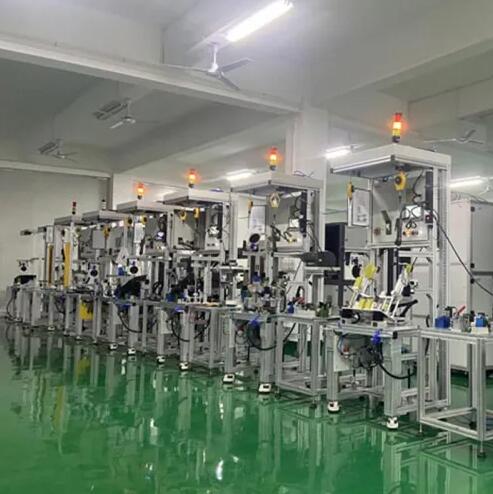What Is an Auto Headlamp Assembly Line?
Oct. 21, 2025
The auto headlamp assembly line is one of the most critical and high-precision systems in automotive manufacturing. As vehicle lighting evolves from simple halogen bulbs to complex LED and laser systems, the assembly process has become increasingly advanced. A well-designed headlamp assembly line ensures not only production efficiency but also consistent quality, durability, and compliance with global automotive standards.
This article explores how an auto headlamp assembly line works, its main components, key technologies, and the benefits it brings to modern car manufacturing.
1. What Is an Auto Headlamp Assembly Line?
An auto headlamp assembly line is a production system that integrates mechanical, electrical, and optical processes to assemble complete vehicle headlights. It typically combines automatic feeding, gluing, welding, testing, and inspection processes in a continuous production flow.
The goal is to produce headlamps with precise alignment, perfect sealing, and consistent performance — ready to be installed directly onto the vehicle.
2. Main Components of a Headlamp Assembly Line
A complete assembly line generally includes several interconnected modules and workstations:
Material Feeding System
Automatically delivers components like reflectors, lenses, covers, and housings.
Reduces manual handling and improves production speed.
Adhesive Dispensing and Sealing Station
Applies precise amounts of glue or sealant between housing and lens.
Ensures airtight and waterproof sealing to prevent condensation.
Lens and Housing Assembly Unit
Automatically aligns and presses components using robotic arms.
Vision sensors verify the correct positioning of each part.
Ultrasonic Welding or Heat Sealing Machine
Permanently bonds the lens and housing without damaging plastic surfaces.
Provides a strong, durable, and clean joint.
LED Module or Bulb Installation Station
Installs LED chips, PCBs, or traditional bulbs into the reflector.
Includes screw tightening and electrical connection testing.
Leak and Waterproof Testing Station
Tests every headlamp for water resistance and air tightness.
Ensures long-term performance in harsh environmental conditions.
Optical and Function Testing
Measures light distribution, beam angle, color temperature, and brightness.
Further reading:
How Much Should an Auto Light Assembly Line Cost?Verifies compliance with automotive lighting standards (e.g., ECE, DOT).
Final Inspection and Packaging
Conducts visual inspection, labeling, and automatic packaging for shipment.
3. Key Technologies Used in Modern Headlamp Assembly Lines
Robotics and Automation:
Robotic arms handle assembly tasks such as positioning, screwing, and transferring components with high precision and repeatability.Machine Vision Systems:
Cameras and AI algorithms ensure accurate part alignment and defect detection in real time.Servo Control and Motion Systems:
Guarantee smooth operation and consistent pressure during lens mounting and gluing.Data Collection and Traceability:
Barcode or RFID tracking allows manufacturers to trace production data for each headlamp, improving quality control.Smart Control Systems (PLC + HMI):
Enable centralized monitoring and parameter adjustments for efficiency and stability.
4. Advantages of a Fully Automatic Headlamp Assembly Line
| Advantage | Description |
|---|---|
| High Efficiency | Continuous automated production significantly reduces cycle time. |
| Consistent Quality | Machine-controlled operations minimize human error. |
| Reduced Labor Costs | Fewer operators are needed for high-volume production. |
| Flexible Configuration | Easily adaptable to different headlamp designs or models. |
| Data-Driven Management | Real-time monitoring helps optimize production and maintenance schedules. |
5. Applications in Automotive Manufacturing
Auto headlamp assembly lines are used by both OEM (Original Equipment Manufacturers) and Tier-1 suppliers for various vehicle types, including:
Passenger cars (LED or halogen headlights)
Commercial vehicles
Electric and hybrid cars
Motorcycles and off-road vehicles
With the rise of LED matrix and adaptive lighting systems, modern assembly lines must meet higher technical requirements for precision and cleanliness.
6. Typical Cost Range
The investment for a complete headlamp assembly line depends on automation level, capacity, and system configuration:
| Type | Automation Level | Approx. Cost (USD) |
|---|---|---|
| Semi-Automatic Line | Medium | $150,000 – $400,000 |
| Fully Automatic Line | High | $400,000 – $1,500,000+ |
| Intelligent Smart Line (AI + Robotics) | Advanced | $1,000,000 – $2,000,000+ |
Although the initial cost may seem high, automated lines deliver faster ROI through reduced labor, higher accuracy, and minimal defects.
7. Future Trends in Headlamp Assembly
Integration of AI and Vision Systems for automatic defect recognition.
IoT Connectivity enabling real-time remote monitoring.
Modular Design for flexible adaptation to new headlamp models.
Sustainability and Energy Efficiency to reduce waste and carbon footprint.
Smart Factory Integration linking production data with MES and ERP systems.
These trends point toward a new era of intelligent, digitalized, and eco-friendly automotive lighting production.
Conclusion
The auto headlamp assembly line plays a crucial role in modern vehicle manufacturing, combining automation, precision, and intelligence to produce safe, high-quality headlights. As the industry continues to evolve toward LED and adaptive lighting technologies, investing in an advanced and flexible assembly line is essential for manufacturers seeking to improve productivity, consistency, and competitiveness.
26
0
0
All Comments (0)
Previous: None
If you are interested in sending in a Guest Blogger Submission,welcome to write for us!





Comments